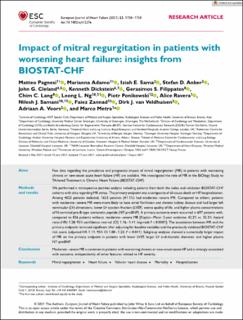| dc.contributor.author | Pagnesi, Matteo | |
| dc.contributor.author | Adamo, Marianna | |
| dc.contributor.author | Sama, Iziah E. | |
| dc.contributor.author | Anker, Stefan D. | |
| dc.contributor.author | Cleland, John G. | |
| dc.contributor.author | Dickstein, Kenneth | |
| dc.contributor.author | Filippatos, Gerasimos S. | |
| dc.contributor.author | Lang, Chim C. | |
| dc.contributor.author | Ng, Leong L. | |
| dc.contributor.author | Ponikowski, Piotr | |
| dc.contributor.author | Ravera, Alice | |
| dc.contributor.author | Samani, Nilesh J. | |
| dc.contributor.author | Zannad, Faiez | |
| dc.contributor.author | van Veldhuisen, Dirk J. | |
| dc.contributor.author | Voors, Adriaan A. | |
| dc.contributor.author | Metra, Marco | |
| dc.date.accessioned | 2022-04-20T11:59:21Z | |
| dc.date.available | 2022-04-20T11:59:21Z | |
| dc.date.created | 2021-11-10T09:07:04Z | |
| dc.date.issued | 2021 | |
| dc.identifier.issn | 1388-9842 | |
| dc.identifier.uri | https://hdl.handle.net/11250/2991630 | |
| dc.description.abstract | Aims
Few data regarding the prevalence and prognostic impact of mitral regurgitation (MR) in patients with worsening chronic or new-onset acute heart failure (HF) are available. We investigated the role of MR in the BIOlogy Study to TAilored Treatment in Chronic Heart Failure (BIOSTAT-CHF).
Methods and results
We performed a retrospective post-hoc analysis including patients from both the index and validation BIOSTAT-CHF cohorts with data regarding MR status. The primary endpoint was a composite of all-cause death or HF hospitalization. Among 4023 patients included, 1653 patients (41.1%) had moderate–severe MR. Compared to others, patients with moderate–severe MR were more likely to have atrial fibrillation and chronic kidney disease and had larger left ventricular (LV) dimensions, lower LV ejection fraction (LVEF), worse quality of life, and higher plasma concentrations of N-terminal pro-B-type natriuretic peptide (NT-proBNP). A primary outcome event occurred in 697 patients with, compared to 836 patients without, moderate–severe MR [Kaplan–Meier 2-year estimate: 42.2% vs. 35.3%; hazard ratio (HR) 1.28; 95% confidence interval (CI) 1.16–1.41; log-rank P < 0.0001]. The association between MR and the primary endpoint remained significant after adjusting for baseline variables and the previously validated BIOSTAT-CHF risk score (adjusted HR 1.11; 95% CI 1.00–1.23; P = 0.041). Subgroup analyses showed a numerically larger impact of MR on the primary endpoint in patients with lower LVEF, larger LV end-diastolic diameter, and higher plasma NT-proBNP.
Conclusions
Moderate–severe MR is common in patients with worsening chronic or new-onset acute HF and is strongly associated with outcome, independently of other features related to HF severity. | en_US |
| dc.language.iso | eng | en_US |
| dc.publisher | Wiley | en_US |
| dc.rights | Attribution-NonCommercial-NoDerivatives 4.0 Internasjonal | * |
| dc.rights.uri | http://creativecommons.org/licenses/by-nc-nd/4.0/deed.no | * |
| dc.title | Impact of mitral regurgitation in patients with worsening heart failure: insights from BIOSTAT-CHF | en_US |
| dc.type | Journal article | en_US |
| dc.type | Peer reviewed | en_US |
| dc.description.version | publishedVersion | en_US |
| dc.rights.holder | Copyright 2021 The Author(s) | en_US |
| cristin.ispublished | true | |
| cristin.fulltext | original | |
| cristin.qualitycode | 2 | |
| dc.identifier.doi | 10.1002/ejhf.2276 | |
| dc.identifier.cristin | 1953017 | |
| dc.source.journal | European Journal of Heart Failure | en_US |
| dc.source.pagenumber | 1750-1758 | en_US |
| dc.identifier.citation | European Journal of Heart Failure. 2021, 23 (10), 1750-1758. | en_US |
| dc.source.volume | 23 | en_US |
| dc.source.issue | 10 | en_US |

